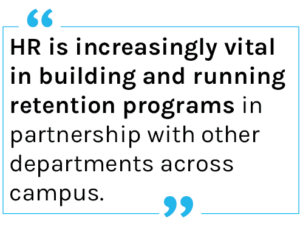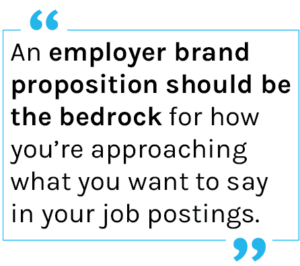As the landscape of higher education has shifted over the last several years, so has the role of HigherEd HR.
HR departments are facing new challenges in higher education as the rest of the campus, including students, faculty, admissions teams, and more, have pivoted to embrace the post-pandemic changes in working and learning. Some of these challenges are driving shifts in the way HigherEd HR departments operate. Read on below to learn about the ways that HR in higher education is changing.
The shifting workforce landscape
HigherEd HR teams are struggling to retain employees, just like many other types of organizations. Job hopping is much more common among Millennial and Gen Z workers than among previous generations, who were more likely to spend their career at a single company.
HigherEd HR departments are feeling this impact even more strongly. While HigherEd has traditionally been an attractive workplace – now, surveys show that more than half of workers are at least somewhat likely to look for a new job in the next year.
There are many reasons for the popularity of job-hopping, including salary increases, desire to explore different types of work or career paths, lack of engagement in the organization, and desire for flexibility or work-life balance. If your institution isn’t active working to improve retention, you’re likely to face under-staffed departments and overworked employees. There are a few ways that HR teams can work to improve retention both in their departments and across campus.
Retention and engagement strategies
First, increase employee engagement by offering career growth and professional development opportunities across campus. Colleges and universities have historically ranked poorly in employee growth and development, but HR can lead the way in offering clear career paths, actionable goals and employee reviews, professional development platforms or online classes, and standardized performance management programs.

Another way to improve retention is to tackle burnout, which has hit HigherEd employees hard. Offering flexibility wherever you can—whether in working hours or working location—can go a long way towards improving employee morale and preventing staff and faculty from seeking roles in other industries that are able to offer remote work.
For employees who need to be on campus, it’s important to emphasize the benefits of being there, like the sense of community or—if applicable—tangible benefits like childcare. Creating a culture of support is also key to preventing burnout. Emphasizing work-life balance and providing resources for physical and mental well-being can also help employees feel valued, supported, and engaged.
HR is increasingly vital in building and running these programs in partnership with other departments on campus, focusing on the holistic employee experience rather than paperwork and payroll.
Overcoming limited hiring pools with recruitment marketing
HigherEd teams aren’t just having trouble retaining employees—they’re also having trouble attracting candidates to fill roles. 77% of respondents in a Chronicle of Higher Education survey reported that “higher education is a less appealing place to work than it was a year ago.” In addition, 62 percent of HigherEd respondents said that hiring today is more difficult than it was in 2022. With this reality of the hiring market, HigherEd HR teams are leveraging recruitment marketing and employer branding in ways they haven’t before.
On a recent panel at PeopleConnect Live, experts from several HigherEd institutions spoke about the importance of recruitment marketing in today’s HR landscape. “HigherEd is always left behind,” said Alicia Barthel, PHR, Director of Talent Acquisition at Texas State University. “Recruitment marketing isn’t new, but we’re newly facing the challenges that others have been for a while which is that we have to actively attract candidates—and that means recruitment marketing.”
HR teams play a central role in building impactful recruitment marketing strategies, including targeted job advertising, building candidate pools, and engaging job applicants with automated communication. Check out this guide for more recruitment marketing best practices and strategies.
Creating an employer brand to stand out from the competition
A key part of recruitment marketing includes building an employer brand—another effort that can be spearheaded by HR.
At the same recruitment marketing panel, Sarah Gasparini, Talent Manager at St. Catherine University, said: “If you don’t already have a strong brand identity, develop one. An employer brand proposition should be the bedrock for how you’re approaching what you want to say in your job postings. What are you consistently telling candidates about what you have to offer as an employer? What are you selling to job seekers?”
proposition should be the bedrock for how you’re approaching what you want to say in your job postings. What are you consistently telling candidates about what you have to offer as an employer? What are you selling to job seekers?”
This type of branding might be new to some institutions, since historically, HigherEd has been able to rely on a strong pool of candidates. Now that the hiring market is so much more competitive, colleges and universities need to actively attract candidates by building an employer brand. Don’t be intimidated, though: look to your admissions office and enrollment marketing teams, who are experts on building a brand to attract students. HR should have an employer brand that is unique from the enrollment team, based on what job seekers are looking for today.
Shift in technology needs
Another challenge faced by HigherEd HR today is the increasing need for digital solutions on all corners of campus. HR teams are embracing technology throughout recruitment, hiring, onboarding, and performance management processes, engaging staff and faculty with digital solutions for their full employee lifecycle. Implementing and training on new tools can sometimes be a challenge, and the quick pivot to technology and remote work in 2020 was a huge undertaking for many institutions, but the positive results have been clear: HR teams now have more time for strategy and programming because they’re spending less time on data entry, email, and paperwork.
Teams are leveraging tools like video interviews and automated communication to engage with more candidates without adding extra work. Digitized onboarding is the norm now, so HigherEd HR teams are using onboarding platforms like PeopleAdmin’s Employee Records to eliminate paperwork and make sure new hires are ready to dive in on their first day.
Final thoughts
HR is facing new challenges in higher education, but luckily, there are strategies that HR teams can embrace in order to overcome those challenges. To learn more about how to tackle retention, hiring, and digital transformation, reach out to our solution experts.